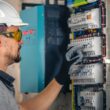Welcome to our comprehensive guide on the Cu AgNO3 reaction, specifically focusing on the AgNO3 + Cu chemical reaction. In this article, we will delve into the intricacies of this reaction, exploring its underlying chemistry, applications, and significance. The reaction between silver nitrate (AgNO3) and copper (Cu) is a fascinating example of a single replacement reaction, yielding intriguing products and holding relevance in various scientific and practical contexts.
AgNO3 Cu Reaction: The Chemistry Behind the Reaction
The reaction between silver nitrate and copper involves the displacement of silver ions by copper atoms, resulting in the formation of silver metal and copper(II) nitrate. This reaction is a classic example of a single replacement or displacement reaction, where a more reactive element displaces a less reactive element in a compound.
The balanced chemical equation for the reaction is as follows:
2 AgNO3 + Cu → 2 Ag + Cu(NO3)2
Here, silver nitrate reacts with copper to produce silver metal and copper(II) nitrate. The silver metal is precipitated out of the solution as a solid, forming a noticeable change in the reaction mixture.
Applications of AgNO3 + Cu Reaction
The AgNO3 + Cu reaction finds applications in various fields, each utilizing its unique properties:
- Laboratory Demonstrations: The reaction is often showcased in educational settings to illustrate fundamental chemical concepts, including redox reactions and the reactivity series of metals.
- Photography: Silver nitrate was historically used in black and white photography for its light-sensitive properties. The reaction plays a role in photographic development processes.
- Electroplating: The reaction is employed in electroplating processes, where a thin layer of silver is deposited onto a copper substrate, enhancing corrosion resistance and appearance.
Significance in Chemistry
The AgNO3 + Cu reaction underscores the principles of chemical reactivity and the transfer of electrons between species. It highlights the concept of activity series, where metals are ranked based on their tendency to undergo displacement reactions. Copper, being less reactive than silver, displaces silver ions from silver nitrate, leading to the formation of the characteristic silver precipitate.
Frequently Asked Questions (FAQs)
Q: What is the primary product of the AgNO3 + Cu reaction?
A: The primary product of the reaction is silver metal (Ag).
Q: What is the role of silver nitrate in this reaction?
A: Silver nitrate serves as the reactant that provides silver ions, which are subsequently displaced by copper atoms.
Q: How is the AgNO3 + Cu reaction utilized in photography?
A: Silver nitrate’s light-sensitive properties are exploited in photography, where it contributes to the development of photographic images.
Q: Why is the AgNO3 + Cu reaction significant in electroplating?
A: This reaction is integral to electroplating processes, enabling the deposition of a layer of silver onto copper surfaces for improved properties.
Q: What educational concept does the reaction demonstrate?
A: The AgNO3 + Cu reaction is often employed in teaching to elucidate redox reactions and the reactivity series of metals.
Q: What is the broader implication of the reaction’s mechanism?
A: The reaction showcases the transfer of electrons between metals, highlighting fundamental principles of chemical reactivity.




